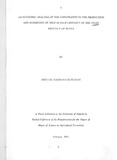An economic analysis of the constraints in the production and marketing of milk in Kilifi District of the Coast province of Kenya
Abstract
This study investigates the milk production and marketing system in Kilifi District.
The purpose is to examine the causes of high producer price in the informal sector and
the decline in milk production in Kilifi District. The study is based on primary data
obtained by interviewing 102 dairy farmers and 76 institutional milk consumers in Kilifi
District. The data collected were analysed using descriptive statistics and regression
analysis. The results of the study indicate that:
i) The genetic potential of dairy animals is one of the limitations to increased milk
production;
ii) Use of credit to finance the dairy enterprise is low due to lack of collateral required
by financial institutions. Access to existing credit facilities for investments and the initial
capital requirement is a barrier to entry into dairy farming by the smallholders;
iii) Informal milk marketing channels are predominant in Kilifi District. Informal market
outlets are also more remunerative to producers than formaL market outlets. The
PRODUCER - CONSUMER milk marketing channel is the most efficient one, based on
the criterion chosen, and yields a net price of Kshs. 7.00 per litre;
Iv) The daily industry in Coast Province is faced with numerous problems, both at
production and consumption levels. Cattle diseases, inadequate credit facilities,
inadequate transportation and poor transport infrastructure, lack of organized milk
marketing system and seasonally low milk prices are some of the factors contributing to
low performance at farm level;
v) The number of lactating animals and market producer price for milk are the most
important determinants of the quantity of milk marketed.
The following recommendations arise from the results of this study:
i) Access to credit by rural smallholder farmers should be improved in order to boost
milk production;
ii) A competent veterinary service and a prophylactic drug supply system should be started
if the disease problem is to be controlled. This is in view of the endemic cattle diseases
in the area. In addition, genetic improvement of indigenous stock should be done. This
can be achieved by upgrading dairy cattle through the use of artificial insemination or
direct purchase of improved stock;
iii) The milk marketing system should be reorganized.for example, through the formation
of the farmers cooperative societies, in order to streamline the marketing of milk by
providing a suitable network of marketing channels that are close to the farmers. This
may create incentives for an expanded output;
iv) Locational and seasonal price discrimination should be instituted in order to exploit
the supply potential in different producing areas. Alternatively, prices should be
decontrolled altogether. The decontrol of the producer price would ensure that quality
and quantity signals from the market are reflected back to the producers. The decontrol
of the consumer price~ would aLso ensure market competition for efficient resource
allocation.
Citation
Echessah, P. N(1994). An economic analysis of the constraints in the production and marketing of milk in Kilifi District of the Coast province of KenyaSponsorhip
University of NairobiPublisher
Department of Agricultural Economics, University of Nairobi, Kenya
Description
Msc-Thesis

